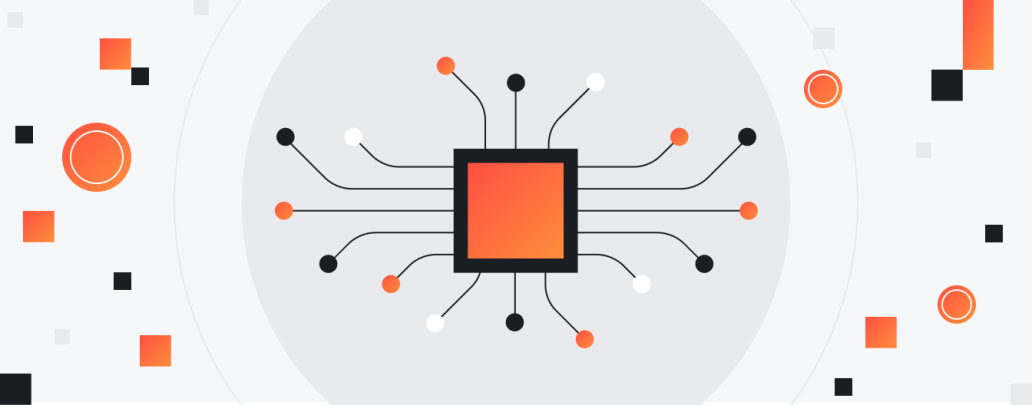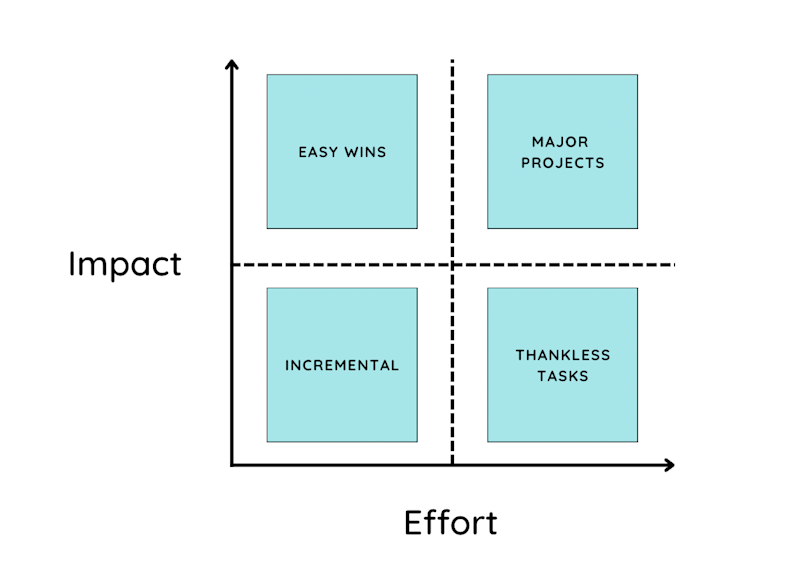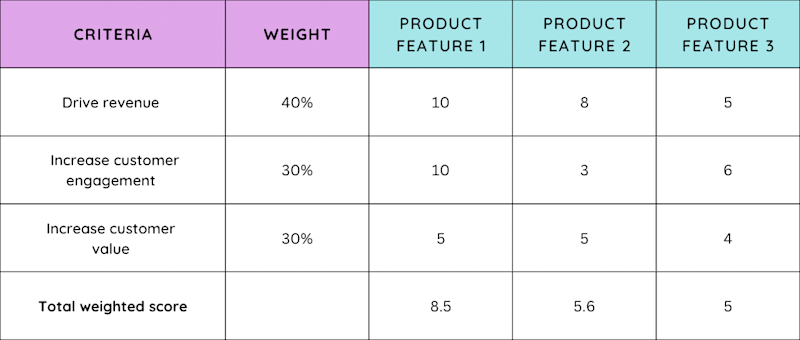The prioritisation frameworks every startup should use

If you're uncertain how to prioritise new products and features, you need a prioritisation framework.
Prioritisation frameworks help Product Managers put the right strategies in place to ensure their teams are working on the product initiatives that will deliver the most value for customers in the shortest amount of time.
In this article we’ll explore prioritisation frameworks and the sets of principles which govern them, to help you determine what your product team should focus and work on next.
What is a prioritisation framework in business?
A prioritisation framework is a set of criteria or principles that teams use when putting product development in priority order.
It’s important to thoroughly explore each framework to find the one that’s most suitable for your business values and customer needs.
The right prioritisation framework will help you make better strategic decisions, avoid standstills in your operational workflows and minimise biases.
Here are some questions to consider when determining the right framework to use:
Are we working on the highest value items?
Are we delivering sufficient product value to our customers?
Is our work contributing to long-term business goals?
Are we keeping up with competitors?
Buy versus build
It’s important to remember that not all product features need to be developed in-house. If you need to bring a new feature to market quickly, you can buy a feature from another company and use it to underpin your existing technology.
Airwallex offers embedded finance solutions which enable fast-growing companies to bring products to market fast. Our APIs allow leading brands such as Plum, and Tradebridge to achieve rapid innovation with minimal lift.
Our product stack includes market-leading FX capabilities, a comprehensive global payments network, multi-currency accounts, card issuing and an online payment gateway. To learn more, speak to our sales team.
Benefits of using a prioritisation framework
In short, a prioritisation framework helps your company figure out what to focus on by giving you the benefit of structure.
A good prioritisation framework will support your company’s decision making process. This allows your team to create a clear and effective road map that not only sets you on a clear route towards your goals, but also improves the likelihood that you’ll achieve them.
Here is an overview of popular prioritisation frameworks. You can decide the one which best suits your needs.
Effort Impact Matrix
The Effort Impact Matrix (also referred to as the action priority matrix) helps you identify activities that will provide the most value for your customers.
You can use the Effort Impact Matrix template to prioritise work based on the amount of effort it requires and the impact it will have on customers, and reduce the amount of time and energy wasted on projects that aren’t providing real value.
The template helps companies prioritise tasks and projects based on the following:
Projects that yield the best results in the least amount of time.
Projects that require more time but the results are worth it.
Projects that have little impact on your customers and their satisfaction.
The matrix is split into four quadrants:
Minimal-effort and low-impact. Activities in this quadrant require few resources but will only provide incremental value to customers.
Maximum-effort and low-impact: Activities in this quadrant require the most amount of time and effort compared to other quadrants and have minimal impact on customers. Tasks in this quadrant are essentially a waste of time. They’re also known as time-wasters or thankless tasks.
High-impact and minimum-effort: Activities in this quadrant are quick wins. They have a substantially positive impact on customers and don’t require much work or effort from you.
High-impact and maximum-effort: Activities in this quadrant have a big impact on customers but they require the most amount of time, effort and attention. Tasks in this quadrant are usually part of major projects.
How do you create an Effort Impact Matrix?
Creating an Effort Impact Matrix requires 5 steps.
Step 1: Get your team together, especially stakeholders, because they have a firsthand, realistic perspective on how tasks are completed as well as the time required to complete them.
Step 2: Identify your company’s main objectives and team goals. Brainstorming these areas helps align your team members and your company’s mission.
Step 3: Create a chart with two axes and four quadrants. The impact on customers upon completion of a task is on one axis and the level of effort required to complete a task is the other axis.
Step 4: Add individual tasks into the quadrants. Plot them based on how much effort and impact each task has.
Step 5: Create a plan of action based on the results of your matrix. Once you have an understanding of the effort and impact of each of your tasks, you’ll have a better idea of what deserves the most time and resources.

When to use an Effort Impact Matrix
Here are a few instances when it’s helpful to use an Effort Impact Matrix:
Resource allocation: If you have limited time and resources, the matrix is helpful when finding the best options to allocate your resources accordingly. It can also help you decide whether to buy or build a new product feature.
Prioritise tasks: The matrix helps you find the most efficient path towards reaching your goals. The tasks that your prioritise allow you to see fast, positive results.
Understand customer needs: The Effort Impact Matrix gives you a better understanding of what makes your customers happy, as well as what they want and need. You should incorporate what they value into your action plan.
[Related: 10 key business metrics every startup founder needs to know]
RICE
The RICE prioritisation framework is a scoring system developed by Intercom’s product management team. RICE stands for four factors that Intercom uses to evaluate products or potential features using a value vs effort scorecard:
Reach
Impact
Confidence
Effort
Reach
Reach is defined by the number of people who are affected by the feature within a given period. Some examples include users per quarter and conversions per month.
So, if you want to find your reach for users per quarter, you take the number of people that visit your site in a quarter and then multiply that by the percentage of them that select a given feature. So if 2,000 people visit your site page per quarter, but only 20% of them use a specific feature through the page, your total reach is 400 people.
Impact
The impact of a certain feature is then scored on an individual level. The scoring scale is 0.5 to 3 based on the level of impact that feature has.
3: massive impact
2: high
1: medium
0.5: low impact
Confidence
A problem that many product managers face is prioritising features without looking into customer feedback. Confidence scores take this problem into account:
Your confidence score is a percentage value:
100%: high confidence in your data
80%: medium confidence in your data
50%: low confidence in your data or lack of data
An example of this could be that you have data to back up that Reach is high, but you’re unsure of the project’s long-term Impact on your company’s success. Your confidence score would then be 80% because you have medium confidence in your data.
Effort
Effort is a score representing the total amount of time a feature requires from your team members to create, manage and more. This score is measured in person-months and the smaller the score, the better.
Let’s say a given feature requires 2 weeks of planning, 1 week of design, 4 weeks of front-end development, and 3 weeks of back-end development. The effort score for this feature is 3 person-months.
To calculate your RICE score, use this formula:
(Reach X Impact X Confidence) ÷ Effort = RICE score
RICE is essentially a strategic prioritisation framework and an objective scoring system. Here are some pros and cons:
Pros: The RICE framework allows you to quantify the impact of the total amount of time spent on developing a feature.
Cons: The RICE framework scoring factors are predefined, so you can’t customise them. Depending on your type of business, this framework might not be the right fit.
MoSCoW
The MoSCoW prioritisation framework was developed by Dai Clegg while he was working for Oracle in 1994. It was first used in the Dynamic Systems Development Method (DSDM), which is a timeframe-based prioritisation framework (agile for project delivery).
MoSCoW prioritisation helps businesses put product features into four categories in conjunction with a fixed timeframe. Here’s what MoSCoW stands for:
Must have (Mo)
Should have (S)
Could have (Co)
Won’t have (W)

When categorising your product features, prioritise the ones that bring the most value to your business early on. The “Must Have” initiatives deliver immediate benefits and are the last to be dropped compared to “Should Have'', “Could Have” and “Won’t Have” initiatives when deadlines are close or resources are low.
Let’s take a closer look at MoSCoW prioritisation.
“Must Have” features are non negotiable when launching a product. One way to know if you “must have” a feature is to imagine if it didn’t exist — would you need to cancel the project? If yes, this is a feature that you cannot drop and is of utmost importance.
“Should Have” features aren’t necessarily the make it or break it in terms of cancelling a project nor vital to a launch. But they’re essential to the overall success of a product. “Should Have” features might be just as important as a “Must Have” feature, but they’re usually not as time-critical.
“Could Have” features are certainly desirable and help make a product successful. But they’re not nearly as important to have as “Should Have” features. If your budget allows, then it’s wise to implement them. Same goes for time. If your project has deadline pressures, it’s usually not a smart move to buy or implement a “Could Have” feature.
“Won’t Have” features are the least valued by customers and have the smallest return on investment. They’re the least critical to have in terms of project success and customer satisfaction.
When you begin categorising features based on MoSCoW prioritisation, you should put all product features in the “Won’t Have” section and gradually justify why to put them in a higher rank.
The MoSCoW prioritisation framework is a great way for businesses to determine what to include and exclude from future product releases. Here are some pros and cons of MoSCoW:
Pros: MoSCoW helps companies identify vital criteria of product launches.
Cons: MoSCoW doesn’t provide a specific method for catagorisation, so there is a risk that projects could be scored based on gut feeling rather than data.
Kano Model
The Kano Model is a type of product management framework developed by Japanese professor, Noriaki Kano and his team in 1984.
This prioritisation framework includes a set of guidelines (and relevant techniques) to inform product development and categorise customer needs to improve customer satisfaction.
The Kano Model is based on the notion that a customer’s satisfaction level is dependent on the functionality of a product feature. Or in other words, how well a feature is implemented and therefore useful to a customer.
As stated, the model contains two dimensions: satisfaction (also referred to as delight or excitement) and functionality (also referred to as implementation, achievement, investment and sophistication).
Satisfaction is on the Y axis because it’s the dependent variable. It ranges from total satisfaction (delighted or excited) to total dissatisfaction (disgusted or frustrated).
Functionality is on the X axis because it’s the independent variable, and shows how well a business has executed a certain product feature. This measurement ranges from “Didn’t do it at all” (none or done poorly) to “did it very well.”
Depending on a customer’s expectations, features are classified into four categories:
Expected (must-be or basic). When a customer buys a product, certain features are expected. For example, a CRM system should allow you to import your contacts.
Normal (or performance). An attractive product has the right set of performance features. The more features you have, the better. But your product should aim to include the right or most important ones.
Exciting (or attractive). Outside of having normal features, you might also want to include ones that aren’t standard. Unexpected or unspoken features make your product more exciting and lead to a more satisfying customer experience. You can review customer feedback and implement certain features to set yourself apart from competitors.
Indifferent. The absence or presence of certain features won’t impact customer value.
Using the Kano Model prioritisation framework is useful when basing your product features on what a customer perceives as valuable. You can ask your customer a couple questions to determine how valuable they perceive certain features.
If you had (x feature), how would you feel?
If you didn’t have (x feature), how would you feel?
Customers have five answer options:
I like it
I expect it
I’m neutral
I can tolerate it
I dislike it
The answers are collected and then put into an evaluation table.
In summary, the Kano model is most useful when you need to make product improvements or create add-on features. Here are the pros and cons of the Kano Model:
Pros: You can prioritise features based on real customer data representing what they perceive as valuable.
Cons: This framework doesn’t account for the complexity or effort of sourcing and analysing customer data.
Weighted Scoring
The Weighted Scoring model helps your business determine what to include in your product roadmap.
Weighted Scoring is essentially an aggregation of reasons that quantify whether a project is high value. You calculate the weighted average based on each feature’s score. The criteria behind why your feature is high value is completely up to you.
For example, say you decide that the criteria behind a new product feature being business critical are:
The product feature drives revenue
The product feature will increase customer engagement
The product feature will increase customer value
You should then assign a weighted score to each criteria depending on its level of importance to your business.
The product feature drives revenue - 40%
The product feature will increase customer engagement - 30%
The product feature will increase customer value - 30%
From here, you can assign each product feature a score depending on how well it meets your criteria. Then you should multiply this score by the weight of each criteria, and add these calculations together to get your total priority score for each feature.
To organise and display your calculations, use a table like the one below.

Pros: Weight scoring allows you to quantify the impact of new product features based on your own criteria, so you can understand what features have the most impact on your business objectives.
Cons: The weight assigned to each criteria is often affected by internal political decisions. This is why all stakeholders should have a say in when creating a list of criteria and features.
How to choose the right prioritisation framework for your project
Choosing the right prioritisation framework isn’t as difficult as you might think, you just need to ask yourself the right questions.
1. How much time do I have to determine our priorities?
If you’re short on time and have minimal data to work with, choosing a basic framework such as MoSCoW prioritisation might suit your needs best. You can always move on to more complex frameworks when you have more time and a better understanding of your goals.
2. Am I able to engage with customers or have sufficient amount of quantitative data to validate my scoring?
Sometimes it’s easy to source the amount of data you need to validate your decisions as a manager. For example, if you log user activity throughout a customer’s journey, you may have more data than you need. If so, an advanced framework will work great for your prioritisation goals. If not, a simpler framework will work best until you gain more data.
3. Can my team sufficiently make data-based decisions?
If your business thrives on data-based decisions, it’s wise to take a quantitative approach to your prioritisation framework. For example, the RICE prioritisation framework may work best for your business. And in turn, you can synchronise your scoring with stakeholders to ensure you agree on the data points and methods that are most important to your priorities.
Upgrade your financial infrastructure with Airwallex
With the right framework, you can choose which projects will have the greatest impact on your customers’ satisfaction and product vision.
You can also decide whether your team has the bandwidth to deliver essential product developments in-house, or whether it makes more sense to invest in third-party technology to get your product where it needs to be.
Airwallex provides embedded financial solutions to tech companies that want to take new products to market fast.
Leading companies use our financial infrastructure to underpin their technology, scale their products and deliver the best experience for their customers. Our product stack includes market-leading FX capabilities, a comprehensive global payments network, multi-currency accounts, card issuing and an online payment gateway.
To learn more, get in touch with our team or sign up for a free Airwallex account today.
Share
View this article in another region:AustraliaUnited Kingdom
Related Posts

Guide to payment gateway integrations: How to get started
•12 minutes

